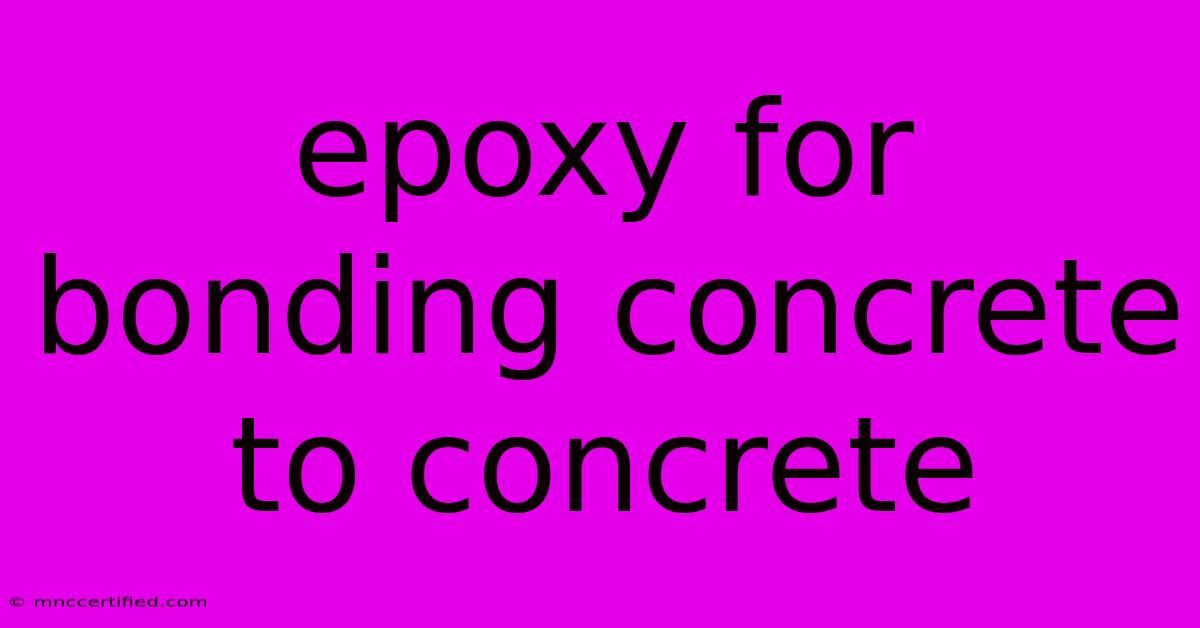Epoxy For Bonding Concrete To Concrete

Table of Contents
Epoxy for Bonding Concrete to Concrete: A Comprehensive Guide
Concrete is a remarkably strong and versatile building material, but even concrete can benefit from proper bonding techniques. When it comes to joining concrete to concrete, epoxy resin stands out as a reliable and robust solution. This guide will delve into the world of epoxy bonding for concrete, exploring its advantages, applications, and the best practices for achieving a successful bond.
Understanding the Power of Epoxy
Epoxy resin, a powerful adhesive, is a two-part system consisting of a resin and a hardener. When these components are mixed, a chemical reaction occurs, leading to the formation of a strong, durable, and waterproof bond. This makes it ideal for a wide range of concrete bonding applications.
Advantages of Using Epoxy for Concrete Bonding
- Stronger Than Traditional Adhesives: Epoxy provides superior adhesion strength compared to conventional adhesives like construction adhesive or mastic. This makes it ideal for demanding applications where the bond needs to withstand high loads and stresses.
- Water-Resistant and Waterproof: Epoxy's inherent resistance to water makes it suitable for both interior and exterior projects, including areas exposed to moisture or water splashes.
- Chemical Resistance: Epoxy can withstand exposure to chemicals and solvents, making it ideal for projects requiring resistance to corrosive environments.
- Versatility: Epoxy can be used to bond various types of concrete, including new and old, as well as concrete to other materials like steel, wood, or brick.
- Durable and Long-lasting: Properly applied epoxy bonds are designed to withstand the test of time, offering long-term durability and reliability.
Applications of Epoxy for Bonding Concrete to Concrete
Epoxy's unique properties make it suitable for a wide range of applications, including:
- Concrete Repair: Epoxy is used to repair cracks, holes, and other imperfections in concrete structures.
- Concrete Patching: Patching damaged areas of concrete with epoxy ensures a strong and lasting repair.
- Creating Seamless Concrete Surfaces: Epoxy can be used to create smooth, seamless transitions between different concrete surfaces, eliminating unevenness and potential tripping hazards.
- Constructing Concrete Structures: Epoxy is used to bond concrete beams, columns, and other structural elements for enhanced strength and stability.
- Anchoring Concrete Fasteners: Epoxy can be used to anchor bolts, screws, and other fasteners securely into concrete.
How to Apply Epoxy for Bonding Concrete
- Prepare the Surfaces: Thoroughly clean both surfaces to be bonded. Remove dust, debris, oil, grease, and any loose or flaking material. Consider using a grinder or a wire brush for a rough surface.
- Prime the Surfaces: Apply a suitable epoxy primer to both surfaces to improve adhesion. The primer creates a more receptive surface for the epoxy.
- Mix the Epoxy: Follow the manufacturer's instructions carefully. Typically, you need to mix equal parts of the resin and hardener thoroughly until a consistent color and texture are achieved.
- Apply the Epoxy: Apply the epoxy evenly to the prepared surfaces, ensuring complete coverage. Use a trowel or a brush for a more precise application.
- Cure Time: Allow the epoxy to cure completely according to the manufacturer's instructions. Avoid disturbing or applying pressure to the bond during the curing process.
Tips for Success
- Choose the Right Epoxy: Select an epoxy that is appropriate for the specific application and environmental conditions. Consider factors such as temperature, humidity, and chemical exposure.
- Proper Mixing: Carefully follow the manufacturer's instructions for mixing the epoxy. Inconsistent mixing can affect the bond strength and performance.
- Apply Evenly: Ensure that the epoxy is evenly distributed on the surfaces, preventing voids and gaps.
- Avoid Over-Application: Applying too much epoxy can create air pockets and weaken the bond.
- Clean Up Immediately: Clean any spills or excess epoxy immediately with a suitable solvent.
Conclusion
Epoxy is a powerful tool for bonding concrete to concrete, providing a strong, durable, and reliable solution for a wide range of applications. By following the guidelines presented in this article, you can ensure successful concrete bonding and achieve desired results for your projects. Remember to always consult the manufacturer's instructions and use appropriate safety precautions when working with epoxy.

Thank you for visiting our website wich cover about Epoxy For Bonding Concrete To Concrete. We hope the information provided has been useful to you. Feel free to contact us if you have any questions or need further assistance. See you next time and dont miss to bookmark.
Featured Posts
-
Scherzinger Apologizes For Hurt Caused By Comments
Nov 09, 2024
-
Ioc On Indias 2036 Olympics Bid Positive
Nov 09, 2024
-
Investment Analyst Interview Questions
Nov 09, 2024
-
The Archers Lose June Spencer Tribute
Nov 09, 2024
-
Western Reserve Insurance Phone Number
Nov 09, 2024